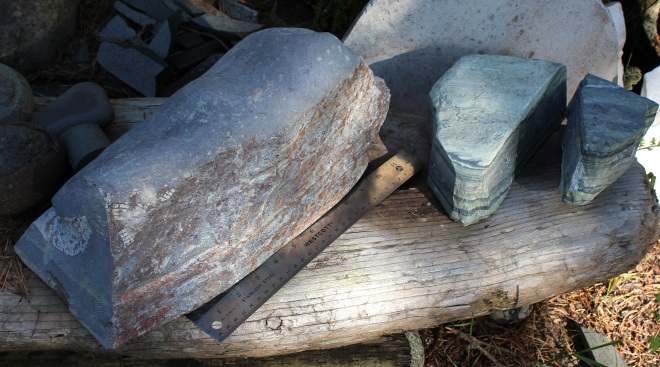Here are samples of two different varieties of Argillite is it said from Alaska. Actually the mineral content and origin of these two samples is unknown, but were obtained from vendors in the puget sound region who also sell stone from Alaska. Argillite is a mud stone created from silt that has undergone transformation. Similar to pipestone in texture. It is a fine grained stone and carves well. These samples show layering and striations due to the accumulation of different colored layers of sediment. Hardness is like a hard limestone so they have metamorphosed and crystalized to some extent.
[Note that you can download the images (drag and drop to your desktop) and you will get a very large image for more detail.]


This close up view shows where a core drill had been used to create cores which were sliced into tokens, then holes drilled into the tokens and then tumble polished to form ornamental beads.


Nice looking stone – is it unduly abrasive on your tools, ala sandstone?
Hi Martin, no the stone isn’t particularly abrasive, not unlike pipestone and other mud stones, though I haven’t done much but polish one surface. Haven’t figured out how to work with small pieces yet. Person who had it before used it to made beads by core drilling, slicing discs from the core, and them tumbling them. He also carved a tiny frog in another sample. So yes fantastic stone I’ll use someday.
BTW I saw your web site, very lovely work, love your fluid style. Also, noted you’re in the northwest as I am.
Thanks.
I’ve actually lived in two northwests – I was born in Lancashire and lived for many years in Oregon, but I now call Colorado home.
I was just explaining to someone the other day the weight of responsibility I can feel sometimes when carving into a fresh piece of stone. Often is the time when I look down on a piece of stone as I am about to carve into it and realize that I know every detail of its formation due to the fact that I have known it in some cases for several years. And knowing that I am about to rip it to shreds and carve it into an unrecognizable shape instills an almost manic desire to do the original stone some justicet – if that makes sense. People can have no idea just how attached we carvers can become to our blocks.
Hi Martin, hope you’re doing ok with all that weather we’re hearing about there in Colorado. And yes I know the sentiment you’re expressing about doing the stone justice when we carve it. And, hey, the idea that my stone tool looking rock may be used for rubbings is an interesting one. Good luck with the weather and your carving.
I hear there is argillite on Texada Island. Can anyone corroborate this? Thank you.
Forgot to ask – as well as it possibly being on Texada, I hear there is also argillite somewhere north of Horseshoe Bay. Can anyone she’d some light on this? Again, thank you!